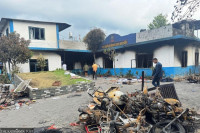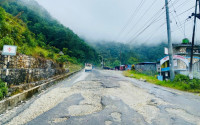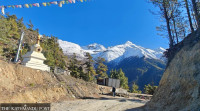Gandaki Province
In Myagdi, child marriages continue despite multi-million rupee campaigns
According to district health authority, nearly 20 percent of pregnancies reported over the last year were underage.
Ghanshyam Khadka
In Myagdi, a hill district in west Nepal, underage marriage—marriage before the age of 20, according to law—is a common practice, especially in the district’s rural belts.
Although the government and non-government agencies have spent hundreds of thousands of rupees to prevent illegal marriages, their methods do not seem to have worked out. Child marriage continues unabated in the district. If anything, this ignominious practice seems only to have increased.
If earlier, child marriage was in practice in certain underprivileged communities, lately it has spread out to other communities as well, said Jag Bahadur Kisan, headmaster of Buddhi Bikas Secondary in Dhaulagiri Rural Municipality-4.
“Awareness drives against child marriage continue and people know it is illegal to get married or get their children married before 20,” Kisan said, “but it’s curious most parents and children continue to disregard this legal provision.”
Kisan recounted to the Post an incident involving a 15-year-old grade 8 student who eloped a couple of months ago and did not return for her annual terminal examinations.
“Marrying early affects their education and their overall course of life,” said the headmaster. “Getting an education should be a high priority for the parents and the children but that is not the case in our area.”
Kisan went on, “Children are dropping out of school as soon as they hit their teens. In the villages, as soon as a child reaches the age of 16, parents start looking for suitors. In some cases, the children themselves elope and get married.”
There, however, is no data on the exact number of child marriages taking place in the district yearly since these marriages are not brought to the notice of the authorities by the parents.
“Most parents worry that their children will not be able to find suitors as they mature,” Kisan said. “Those who get married under the age of 20 also hide the real age of their children to avoid legal hassles. There is no record of child marriage except for a few cases in court.”
According to data from Myagdi district court, in the fiscal year 2021-22, Beni, the district headquarters, saw only two child marriage cases. Among them was a complaint filed by a non-governmental organisation to annul a marriage that had taken place with the consent of both families. Another was an inter-caste child marriage case.
Shankar Nepali, the programme coordinator of Bal Majdur Sarokar Group, Nepal, filed a complaint with District Court Myagdi on June 7, 2021 for the annulment of a marriage involving an underage couple from Dhaulagiri Rural Municipality-7. Nepali had written to the district court demanding arrest of and action against the parents of both the underage bride and groom.
“Police investigation revealed that the marriage was arranged and happened with traditional rites but no legality,” said Nepali.
Similarly, another case against child marriage was filed in the district court on July 5, 2022. A 22-year-old boy of Mangala Rural Municipality-4 married a 17-year-old girl from the same place. The dissatisfied girl’s family filed a case because it was an inter-caste marriage. The boy was arrested and the girl handed over to her parents.
According to Tej Prasad Paudel, District Court Registrar, these are only cases of child marriage registered in the court in fiscal year 2021-22. “In the first case, although the marriage was legally annulled, the young couple have decided to live together,” said Paudel.
Beyond these sporadic cases, data from the Health Office, Myagdi confirms the widely prevalent malpractice across all religions, castes and communities of the district—from July 16, 2021 to June 13, 2022, out of a total of 1,574 pregnant women who went to health institutions across the district for their first pregnancy check-up, 293 people were under the age of 20, that is 18.63 percent of the total reported pregnancies in the district.
In the remote Dhaulagiri Rural Municipality, 36 women under the age of 20 went to the health institution for their first pregnancy test. In the same period, 90 people under the age of 20 have undergone pregnancy tests in Beni Municipality, where urban and relatively educated and financially prosperous people live.
Forty-six underage girls in Mangala Rural Municipality, 69 in Malika Rural Municipality, 25 in Raghuganga Rural Municipality, and 27 in Annapurna Rural Municipality have reached the health post in different parts of the district for pregnancy checks.
Prakash Sharma, information officer at the health office, said that, in the fiscal year 2021-22, 54 people under the age of 20 had medical abortions and one person had a surgical abortion.
“These cases do not come to the police or the court because people in rural areas believe that the legal marriageable age set by the government is too high,” said Paudel, the district court registrar. “Cases of child marriage are reported to authorities only when it is an intercaste marriage, or if there are dowry issues.”
Sangam Myagdi is the only organisation working in the field of children throughout the district.
According to Deepak Poudel, chairman of the district wing of NGO Federation of Nepal and president of Sangam Myagdi, around Rs9 million amount was spent in the last two years for campaigns and awareness programmes to end child marriage.
The municipal office, too, has made its efforts. For two years, it conducted an ‘Age Appropriate Marriages' programme spending Rs5,00,000, according to Resham Chantyal, vice-chairman of the Dhaulagiri Rural Municipality, before it was stopped due to the pandemic.
Despite these efforts, however, the situation remains the same, especially in the remote areas of the district, Poudel said. “It seems like no one is ready to stop child marriage,” he said.




 7.12°C Kathmandu
7.12°C Kathmandu.jpg)










